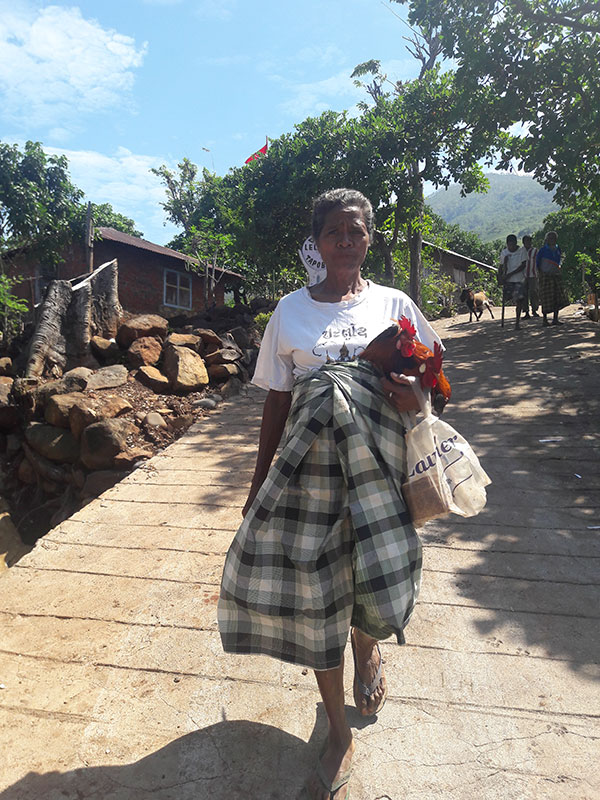Bricks, Baskets and Bartering in Lembata and East Flores

Brick making process
When we were arrived on the south coast of Lembata we met a man with his son making cement bricks for the son’s new house. The son will marry soon and he has to have his own house or the church will not allow the marriage. Local people do not make a detailed calculation on how many bricks they need, they just estimate. Even without detailed calculations their estimate is usually right. With my background in architecture, I was so impressed with them. Local people are smart!
There are two types of granary in this area, the lefat and the fetak. A lefat used to store corn, rice and peanuts. A fetak is used to store seeds that will be used in the next planting season. When harvesting crops they will be temporarily kept in the fetak and then will be moved little by little to the lefat once the harvest is done.

A lefat granary under construction

Bola fatil used to store textiles
This beautiful basket is locally called Bola Fatil and it is used to store food and heirloom objects like textiles. It is also carried on the head when a woman goes to market. Storage in a Bola Fatil will keep the colour of textiles strong and protect them from rats and insects.
Chicken have a really important role in ceremonies throughout East Nusa Tenggara. This woman is carrying a chicken as a wedding gift from the groom’s family to the bride’s family.

Woman carrying chicken for Surat Dori ritual

The groom’s family and clan members bring wedding gifts to the bride’s family
We were lucky to see the Surat Dori ritual, which is part of the wedding ceremony when the groom’s family visit the bride’s family for formal introductions. All the family and clan members of the groom will go to the bride’s house. Rice, corn, bananas, cassava, chickens, pigs, dogs, and goats are brought as gifts.
In Lamalera, we saw the weekly barter market. It is held every Thursday just for one hour and usually starts between 9 and 10 am. It was really interesting to see how they do the bartering. Between the seller and the buyer there is no talking. They show their goods to each other and if they agree then they exchange. All bargaining is done through body language. The barter market was held in Wulandoni, a two hour walk from Lamalera, but moved to Lamalera a few years ago.

Barter Market in Lamalera

Higi is essential in the textile making processes
There are many steps in making a piece of textile. Near Larantuka we saw a weaver applying the higi proses. This is done after dyeing, and after the ikat is opened, and involves rearranging the warp on a frame and securing sections of the motif to a bamboo stick, so ensure is does not move. This is an important process before weaving that can impact the clarity of the pattern.
We are always happy to meet the weavers and we always find something to laugh about together. Our relationship with the communities is the most importance thing. That is why we try to visit every community twice a year as a way to maintain relationships. The communities treat us like we are family not just buyers.

Threads of Life fieldstaff, Gde, talking to a weaver

Local food served by a weavers group
One of my favorite things when visiting the communities is having lunch or dinner together in the village. It is usually a local menu of rice, vegetables and sambal (local hot sauce). Sometimes we have eggs and meat. The food is cooked in a very simple way with local spices that grow around the village. Fresh, healthy, and of course DELICIOUS!
With introductions from the Nusa Tenggara Association (NTA; nta.org.au) and Nani House, this was our first visit to the Akasia cooperative in the Botang area of Sikka. There are 23 women in this group and they have just started working with natural dyes.

Akasia Weaving Group was listened to Threads of Life fieldstaff’s explanation

The meeting with Sukamaju cooperative
One of NTA’s projects related to income generation is to connect weaver groups to the market. The Kelompok Sukamaju in Namang Kewa, Sikka, is another weaving group NTA works with. Here, most of the women are making both natural and synthetic dyes textiles. The synthetic dye textiles are for the local market while the natural dye textiles sell through an organization in Nita area.
The last NTA group we visited was the Bida Mitang cooperative. This group is located in Nilo, which is a tourist attraction in East Flores. Many people visit this group and buy textiles from them. We found only old people still make natural dye textile using traditional methods while the young weavers use synthetic dyes.

The ikat process needs lots of concentration and patience

Yansen and Gde with the Bida Mitang cooperative
The Bida Mitang group also performs traditional dances when visitors come to the village. Weaving has become the main women’s activity in this area. Many visitors come to see culture because the community still maintains its local traditions.

